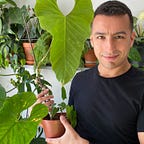Why Hoyas are great houseplants for the serial plant killer
Hoyas are native to tropical Asia and some of the western Pacific as far as Australia. In the wild, they can be found as epiphytes climbing through the trees in search of light.
There seems to be a consensus amongst houseplant enthusiasts that if you want to be successful with hoyas there are two schools of thought. The first is to simply ignore them entirely and the second is to treat them as shade-loving indoor succulents.
In my experience both of these are true. I’ve found that the reason I and some others have been unsuccessful with hoyas in the past is simply due to the fact that most new plant parents love to fuss over their plants. We want to water them often, we want to touch them and make sure they are ok all of the time.
Just leave them alone, and your plants will thrive. Below I will list my hoya care regime:
Light
Hoyas love bright filtered light that mimics the defused light they would receive rambling through the forest. Direct sunlight can often burn the leaves of your plant. I grow most my of hoyas in east-facing rooms out of reach of direct sunlight. This means that when the morning sun streams into the room my plants will get bright light, but no direct sunlight. If you place your hoyas in lower light you are likely to get stretched growth and little to no flowers.
Watering
Watering can be a big stumbling block for hoya enthusiasts because hoyas love to dry out in between waterings. These periodic dry spells guards against issues such as root rot. I give my bigger hoyas a thorough watering once every two weeks during the colder months. This is known as the drench and dry method. My smaller plants I water about once a week in summer and once every two weeks in winter.
If you are a forgetful waterer then hoyas could be the ideal plant for you!
Humidity
The more thick and succulent leaved Hoyas like Carnosa, Obovata, and Publicayx are tolerant of lower household humidity. As a rule, I like to expose my hoyas to 60% humidity, and they really seem to thrive. I don't have any of the thinner-leaved varieties in my collection, but I have heard that it can be difficult to keep them happy in anything less than 80% humidity.
A humidifier is the most effective way to raise the humidity around your plants. I use a cool humidifier but you can also use a warm humidifier if you wish. Alternatively, you can also set a group of smaller hoyas on a tray of moist pebbles making sure that the plants are not standing directly in the water as this will cause the roots to fail.
Repotting
Hoyas like to be root bound, this is due to their epiphytic nature in the wild they can often be found growing in small pockets of substrate. Regular repotting is not needed for hoyas Instead, you can change their growing medium and pot them into the same container when your plant is becoming root-bound.
Potting Medium
As mentioned previously being epiphytic hoyas have adapted to having lots of air around their roots. When choosing a substrate make sure to select one with perlite or bark mixed into aim drainage. Alternatively, you can amend ready made potting mix. You potting can use a 50/50 split for example 50% potting mix and 50% perlite.
Temperature
Average home temperatures as acceptable to hoyas. If the temperature dips below 10°C you might start seeing some cold damage on your hoyas, especially the more tropical species.
In the Northern Hemisphere, it is best not to do postal orders during the late autumn and winter months without heat packs to help shield your plants from the cold.
Fertilizer
I love using organic fertilizers on my hoyas, they are not heavy feeders and enjoy weaker applications. I use kelp, fish emulsion, and worm castings as fertilizer for my hoyas. Generally, I would apply these once or twice a month. Worm castings can be applied across the surface of the soil to act as a slow-release fertilizer.
Pests
The most persistent pest I’ve had to deal with with my Hoyas have been mealybugs. They seem to have a penchant for my Carnosa and Publicalyx. I combat mealybugs by applying neem oil as a preventative spray. you can also dab individual bugs with cotton dipped in rubbing alcohol.
Houseplant pests often hide amongst dust particles on the leaves of your plants. I rinse my plants in the shower ever so often to remove dust, this can also help deter any pests from your hoyas.
I hope that you've enjoyed this story. I’ll be posting my houseplant care guides twice a week!
Corbin
